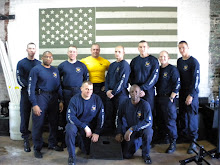CF 864- Today's schedule 9:00a.m. (starting next week we will add 5:15am)
Day 38 of the "100 burpee challenge"
WOD - For Time
5 rounds of:
9 Weighted Good Mornings
15 Kettlebell Swings (M-55#/F-35#)
21 Overhead Walking Lunges - left/right lunge = 1 rep (65/45)
“For the word of God is living and active. Sharper than any double-edged sword, it penetrates even to dividing soul and spirit, joints and marrow; it judges the thoughts and attitudes of the heart.”
- Hebrews 4:12
"IF YOU WANT SOMETHING YOU'VE NEVER HAD,YOU HAVE TO DO SOMETHING YOU'VE NEVER DONE"
-anonymous
CrossFit is the pursuit of athletic perfection—performing difficult workouts with technical mastery under conditions of duress. We’re looking for flawless form with a jackhammering heart, bursting lungs, and battery acid-filled veins.
When this is accomplished with unyielding intensity, the result is nothing short of beautiful. When we fall short of the mark, the result is horrifying at best.
Athletes often set up a false dichotomy between perfect form and intensity, assuming that as one increases the other must necessarily fall. This idea is a thinly disguised excuse for athletic complacency. Rather than revisit proper technique through low-intensity, low-excitement skill work, the athlete chooses to pursue personal records with diminished form. The unstated reason for this choice: it’s easy on the ego to put up “good” WOD times. Taking a hit to your “Fran” time in order to perform perfect thrusters is not going to move you up the records board—at least not right away—and the blow to the ego is too much to bear.
In reality, form and intensity are not mutually exclusive, but the non-linearity of their relationship leads novice athletes to the wrong conclusion. For the novice, maintaining form becomes a cruel joke as intensity increases, leading to the erroneous conclusion that the two cannot coexist. Advanced athletes believe the opposite. These athletes recognize that continuous high-intensity work is nearly impossible without strict attention to form. The advanced athlete knows that perfect form is perfect for a reason: it imparts structural advantages that poor form does not.
Take the thruster as an example. Performed poorly, the movement relies on the small muscles of the anterior shoulder to support the weight at lockout. These muscles fatigue extremely quickly, leaving the athlete with reduced capacity in short order. When the thruster is performed well, the weight is supported by the large, hard-to-fatigue muscles of the posterior chain, allowing the form-conscious athlete to continue at peak power long after his sloppy brethren have stopped to rest.
The advantages of good form are not isolated to the thruster. Clear structural advantages can be had in the majority of our movements if one chooses to pursue perfect form. Most of these advantages are based on the physics of power transmission, specifically the fact that it is easier to send power through a rigid structure than through a limp one.
Squatting provides a wonderful illustration. The squat utilizes power from the hip to propel the torso through a complete range of motion. If the spine is rounded and the torso is loose, power is lost and the torso becomes difficult to move. If the spine is kept in a neutral or arched alignment and the torso is rigid, as proper form dictates, power flows freely and the load is easy to move. Nonetheless, we’ll often see novices blasting through flaccid, rounded-back squats, heedless of the power-draining effect of their substandard form.
Condoning bad form for the resulting intensity ignores the big picture. In doing so, we rob our athletes of their long-term potential, artificially capping their progress in the name of immediate gratification. An athlete with poor form and an ugly three-minute “Fran” will always have an ugly three-minute “Fran”, while a similar athlete with good form will soon find himself pushing the limits of possibility, utilizing the structural advantages of the perfect thruster to close in on two minutes.
For the CrossFitter, perfection should be non-negotiable, regardless of the near-term outcome. Progressing to the elite level—heart jackhammering, lungs bursting, and records falling—depends on it.
The difference between a structurally solid lockout and its weak cousin is obvious.
-Jon Gilson
Hard.Fast.Brutal
CrossFit
Have an awesome day!
3-2-1- Go!
Jay and Janice
Subscribe to:
Post Comments (Atom)





















No comments:
Post a Comment